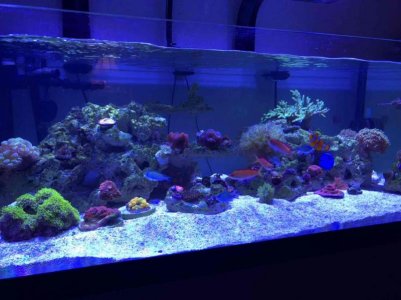Curious, what was your nutrient issue? Apologies if you discussed it earlier but I didn't see it on the most recent update. I have a similarly sized tank that is doing fairly well but I am not getting the colors that I would like. I also have a history of zoas melting, both of which I am attributing to low nutrients. My nitrates and phosphates are 0 but I'm not sure I'm ready to start dosing. I may start with adding more fish and upping my feeding regimen to see how that goes. Interested to hear what your issue were.
I've had ups and downs with nutrients over the years and have generally attributed issues to nutrients being too low. I believe part of my coral crashing episode (11/2017) was due to Nitrates and Phosphates being far too low. The other part I firmly believe was due to running my T5 bulbs too long, but there is great debate with that one, so I'll leave it there. :lolspin:
There are people with awesome acro tanks on this forum who run ULNS such as Nitrates under 1ppm and Phosphates under 0.01ppm. My tank
does not do well with that. IMO, soft corals such as zoas definitely prefer higher nutrient water, but I've found acros do as well.
The first thing you need to figure out is how to properly test for them. For phosphates, the only reliable and repeatable test I have found is the
Hanna HI736 Phosphorus ULR tester. For Nitrates, there are several good ones to choose from like Salifert and Red Sea. I personally prefer
NYOS.
So you're now reliably testing and your Nitrates/Phosphates are still too low. There are two ways to increase them, the un-natural way and the natural way. I have dabbled in the un-natural way by dosing Nitrate and Phosphate but that was also just before my coral crash, so I would urge caution! :thumbdown
The natural way is to increase feeding. You can feed your corals (ReefRoids, etc.) or feed your fish. I prefer the latter. I'm a firm believer that corals, particularly acros do well when there is enough fish poop being released into the water. Good lighting and Fish Poop should be all they need for food. To do this method it's simple, just add more fish and feed them. I would suggest adding no more than one fish/month and test a couple times a week to see how your tank is adjusting. When you hit the nutrient level you want, stop adding fish and adjust fish feeding to maintain your levels.
I shoot for around 5ppm Nitrate but it varies between 4-6ppm. I shoot for around 0.03 Phosphate, but it's been running closer to 0.07 the past few months and the tank is doing well so I see no need to change.














